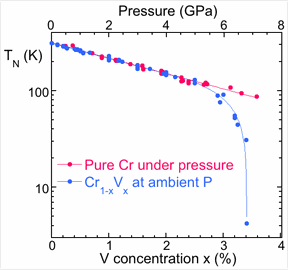Denis McWhan still vividly remembers his Physical Review Letter on the effect of pressure to the antiferromagnetic ordering in chromium, 40 years after its publication:
“Before doing experiments I usually went in to see Conyers Herring to bounce ideas off of him. I asked whether it would be interesting to determine the critical pressure for the suppression of antiferromagnetism in [chromium (Cr)] and his response was, ‘Where are you going to get the megabar?’ I said, ‘Oh, no problem. The Néel temperature drops at 6 degrees per kilobar, so I only need 60 kbars.’ He smiled and said I should try the experiment.”
This exchange led to the first real attempt to characterize the magnetic P-T phase diagram of chromium. The study of magnetism in Cr was still in its infancy in 1967 when McWhan discovered the exponential dependence of the magnetic order on pressure, thereby validating a seminal theory of spin density wave magnetism and anticipating the modern interest in so-called quantum phase transitions. Today, Cr stands as the archetypical spin density wave system; nevertheless, the P-T phase diagram remains incomplete. It seems fitting, therefore, that the next advance in the phase diagram of this model system was also published in Physical Review Letters exactly 40 years later. The work was led by Yejun Feng (XSD-MM) and graduate student Rafael Jaramillo, working in the group of Prof. Thomas F. Rosenbaum at The University of Chicago, in addition to a group of scientists from both the Advanced Photon Source and the Center for Nanoscale Materials at Argonne National Laboratory, and from the Carnegie Institute of Washington and the University College of London.
The study of magnetic phase diagrams is essential to understanding the organizing principles of correlated electrons, as well as understanding the way in which physical parameters determine material properties. Advances on an important model system such as Cr are therefore relevant to two separate but parallel fields, one being the fundamental physics of emergent magnetism, and the other the development of advanced materials for technological application. The emergence of magnetism at very low temperatures is controlled by quantum mechanics rather than thermal energy. The theory of such so-called quantum phase transitions, first formulated in the 1970s by John Hertz at The University of Chicago, has become central to our modern understanding of correlated electrons and is an important tool in the study of enigmatic materials such as high-temperature superconductors and so-called heavy Fermion systems. However, due to the inherent complexity of such systems there is a need to understand the relevant physics in a simplified model system such as Cr. On the technological front, the ability to produce useful electronic and magnetic materials by tuning physical parameters holds tremendous promise for the electronics and information processing industries. Studying the effect of pressure on magnetism elucidates the dependence of electron correlation on lattice spacing and helps clarify the effects of chemical doping.
To address these questions, the researchers employed a new generation of instruments: high-energy synchotron radiation at Advanced Photon Source sectors 4 (X-ray Operations and Research) and 16 High-Pressure Collaboration Access Team), laser-diced miniature single-crystal samples, and a membrane-controlled diamond anvil cell to provide adjustable high pressure at low temperatures, all of which were unavailable to McWhan in 1967. In fact, this work is believed to be the first time non-resonant x-ray magnetic scattering has been applied for the study of magnetic ordering under pressure.
The results of this study yield insights into the microscopic ordering of itinerant magnetism in Cr under pressure which are only accessible to high resolution x-ray diffraction. The authors make the case for a semi-rigid band structure approaching the quantum phase transition and pinpoint the exact functional forms for the evolution of the spin and charge order parameters. From these results it is concluded that the magnetism is destabilized by an increase in electron kinetic energy relative to the magnetic potential energy.
This effect of pressure on magnetic order is readily compared to that of chemical doping. By collapsing the phase diagrams of both pressure and vanadium doping (see figure) the divergence of these two approaches to quantum criticality is brought into sharp relief. Whereas under pressure the exponential suppression continues to the highest measured pressures, with doping such evolution is cut off above a dopant concentration of 2.5%. Chemical doping, which is characterized by both static disorder and a varying electron density, therefore hastens the onset of quantum criticality.
This work expands the phase diagram of a canonical model system and provides new insights into the microscopic details of itinerant magnetism. By probing both spin and charge order using x-ray diffraction it was possible to identify the driving factor in the suppression of magnetic order. The resulting picture is delightfully simple and suggests that chromium under pressure may well be an ideal laboratory for the study of emergent magnetism at a quantum phase transition. To this end, the same group of researchers at The University of Chicago and the Advanced Photon Source are actively pursuing the critical region, where the disappearing diffraction signals and stringent requirements for pressure control make the experiment more challenging than ever. - Yejun Feng
Contact: Yejun Feng, [email protected]
See: Yejun Feng, R. Jaramillo, G. Srajer, J. C. Lang, Z. Islam, M. S. Somayazulu, O. G. Shpyrko, J. J. Pluth, H.-k. Mao, E. D. Isaacs, G. Aeppli, and T. F. Rosenbaum, “Pressure-Tuned Spin and Charge Ordering in an Itinerant Antiferromagnet,” Phys. Rev. Lett. 99, 137201 (2007).
DOI: 10.1103/PhysRevLett.99.137201
The work at The University of Chicago was carried out under NSF Grant No. DMR-0534296. G.A. acknowledges the Royal Society for financial support. R. J. thanks the NSF Graduate Research program for financial support. Use of APS was supported by the U. S. DOE-BES, under Contract No. NE-AC02-6CH11357. Use of HP-CAT is supported by DOE-BES, CDAC, NSF, and the W. M. Keck Foundation.
Argonne is a U.S. Department of Energy laboratory managed by UChicago Argonne, LLC

